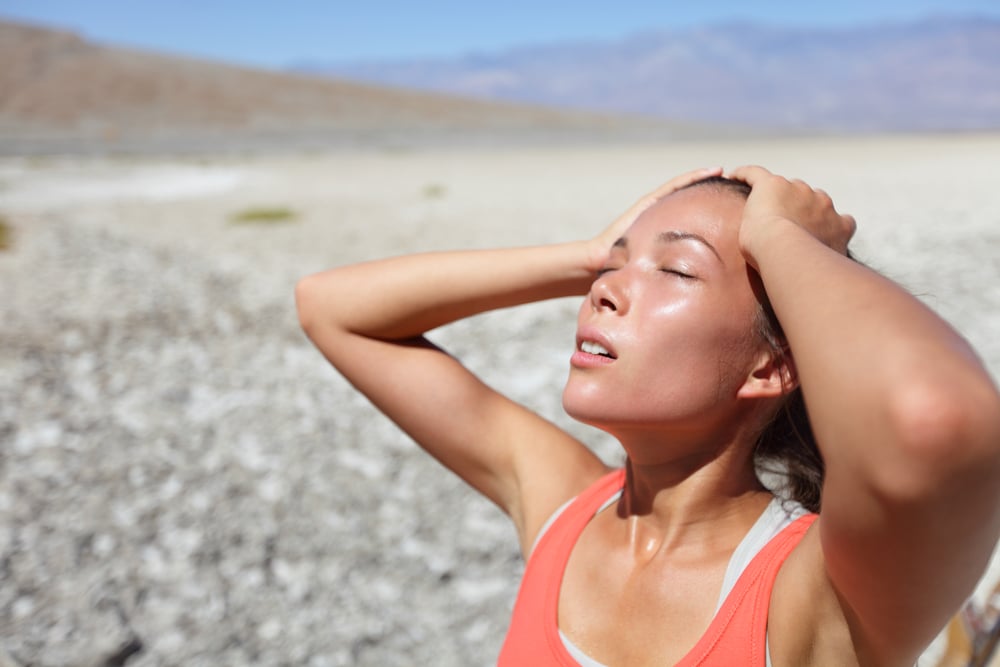
In a study published in the journal Headache, 10% of respondents to a survey reported experiencing a dehydration headache. In a separate study, 24 out of 95 respondents considered dehydration a migraine trigger.
These studies suggest that dehydration can cause a headache, while in some, it triggers a migraine. In other instances, dehydration is the result of other issues such as vomiting or diarrhea, but regardless of its cause, a headache may not be far behind.
For migraineurs, all of this is quite entangled. Fortunately, many of the preventatives and treatments for dehydration headaches work equally well for migraines.
Defining the Dehydration Headache
A dehydration headache is considered a secondary headache; the head pain is caused secondarily to the dehydration. Dehydration is caused by the lack of fluid in the body. Dehydration headaches can be mild, or they can be as severe and painful as a migraine.
The pain is caused when the brain shrinks away from the skull due to the lack of water or fluid loss. The contraction is temporary, and the brain returns to normal after rehydration.
Symptoms of a Dehydration Headache
Like most other physical ailments, you are unlikely to experience all possible symptoms. However, if you suffer from anything on this list, dehydration should be one of your first guesses at your problem. Some individuals don’t experience dehydration until it becomes severe.
The headache itself can be dull or intense. It may occur at the front, back, side, or all over the head. It might be a pulsating pain on both sides of the head that is made worse by physical activity. For example, moving your head, bending down, or walking may exacerbate the pain.
Unlike sinus or tension headaches, dehydration headaches rarely cause facial pain or pressure or pain in the back of the neck. You can tell dehydration headaches from migraines because the pain tends to be severe on one side of the head. You may feel nausea and/or a visual aura.
Besides headache, other symptoms of dehydration include the following:
- Extreme thirst
- Reduced urination or darkly colored urine
- Confusion, dizziness, or fatigue
- Dry, sticky mouth, dry lips, dry eyes
- Loss of skin elasticity
- Low blood pressure and/or increased heart rate
Other potential symptoms, especially if the dehydration becomes severe, include:
- Lack of sweating
- Sunken eyes
- Fever and/or delirium
- Shriveled skin
- Unconsciousness
- Muscle cramps
For migraine sufferers, it can be difficult to tell the difference between dehydration headaches and migraines. Symptoms such as nausea or GI upset can be present during prodrome, but these symptoms can also be caused by dehydration.
To make things trickier, dehydration can cause nausea, possibly due to low blood pressure.
In any case, the same treatment helps both migraines and dehydration headaches.
Causes of Dehydration Headaches
Dehydration headaches only occur when the body isn’t receiving enough water for its needs. Usually, the volume of water going in matches the volume leaving the body, but dehydration may be the result if that balance is upset.
Dehydration can be caused by physical exertion or hot weather that causes excess sweating. High humidity often makes sweating and dehydration worse.
Other problems that may increase the risk of dehydration include:
- Diarrhea - some migraine patients suffer from irritable bowel syndrome along with migraine
- Vomiting
- Extreme sweating
- Fever
- Excess urination (diuresis) - some migraineurs report the need to urinate increases during the prodrome phase of a migraine attack. It may result in dehydration and, if accompanied by nausea, you may not want to drink anything.
Some people are at higher risk of dehydration than most:
- People living at high altitudes or in hot climates
- Young children and infants
- The elderly
- Individuals with chronic illnesses such as diabetes and kidney disease
- People taking diuretics, medications that increase urination
- Endurance athletes
It’s easy to see why dehydration headaches are common enough for people to identify the cause.
Treatment
The best thing to do in case of a dehydration headache is to quickly treat both the pain and the dehydration. Be careful not to over hydrate as that could aggravate nausea.
The primary treatment includes increasing fluid intake. A glass or two of water will help most cases. If drinking water doesn't sound good, try sucking on ice cubes. Otherwise, sip the water slowly. In emergency situations, healthcare providers give additional liquids in an IV to treat both dehydration and migraines.
Replace lost electrolytes with a sports drink or pediatric electrolyte replacement solution. Typically you obtain all you need from food and beverages, but excess sweating, urination, diarrhea, or vomiting can reduce your electrolyte balance, affecting body function.
Stay away from excess sugar and caffeinated beverages as well as OTC medications with added caffeine since that is another common migraine trigger. Also, caffeine is a diuretic and causes you to urinate more.
Temporarily reduce your physical activity and avoid the heat to reduce sweating.
To reduce pain, use an OTC pain reliever like acetaminophen, ibuprofen, or aspirin. Always check with your physician before starting any new medication. If nausea occurs, you may be given anti-emetics (anti-nausea drugs) that often help with migraines as well.
A cold compress against the forehead along with lying down in a dark, quiet room can ease headache pain as well.
Seek medical care immediately for severe dehydration to prevent serious complications like kidney or brain damage, seizures, shock, or death.
Preventing Dehydration (and the Headaches That Follow)
Take care to keep yourself hydrated. How much is enough? There aren’t any firm guidelines, but one study suggested women drink at least four to seven eight-ounce cups of water. Men should drink between six and eleven cups. Another piece of advice for migraine sufferers is to drink an additional 1.5 liters of water daily over your typical intake.
Tips on helping you drink enough:
- Fill a jug or pitcher in the morning with the amount you think you should drink. Make sure half is gone by lunchtime.
- Carry a reusable water bottle in the car or your bag for easy access. Find one you enjoy using.
- Add a sugar-free drink mix, fruit, or mint to improve the water’s taste.
- Take water with you on your workout.
Eating foods rich in fluid, like cucumbers or other vegetables high in water, and fresh fruit. Spread fluid intake over the course of the day and hydrate more while exercising.
Fever and infection can create conditions for dehydration, so attend to those issues and drink more water.
Dehydration headaches are relatively common; many people have reported having one. Migraineurs may also suffer dehydration headaches that may be as severe as a migraine. Drinking plenty of water throughout the day helps prevent both kinds of head pain. If you do get a dehydration headache, the best thing to do is slowly drink a glass or two of water and take an over the counter pain reliever.
If you suffer from more than the occasional dehydration headache, make an appointment with your healthcare provider to determine why.



